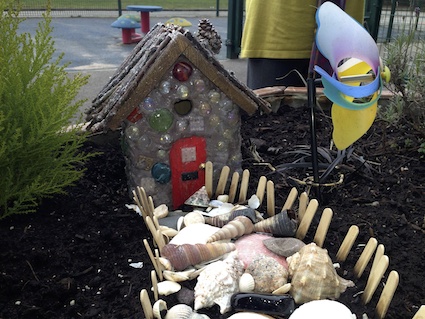Recently I visited Westpark Nursery in Aberdeen, which had been donated a large raised bed – the sort that is traditionally used around towns for floral displays. At first the staff and children wondered how to use it as it seemed too big and too high to be of any real use.
Then a spark of inspiration via online sites, made one member of staff suggest to the children that they could create a fairy garden and so began an ongoing project which has lasted more than half a year and become a key part of the outdoor play within the nursery. This included the children buying and planting the flowers, creating the fairy house from an old bird box and raiding resource boxes for the shell path.

The highlight of the project was when the fairies finally arrived. The children immediately used them for playing hide ‘n’ seek around garden. The play has not been the domain of the girls. The boys at this nursery are equally interested and fascinated with the fairy garden.

On a recent early years literacy course we used the fairy garden and the children’s interests as a context for literacy. We brainstormed some ideas as there’s nothing like a bit of shared thinking.
Here’s what we came up with:
- Let the children think of names for each of the fairies and for each fairy to adopt one of the shrubs. Each shrub could then have a small sign.
- Wondering what sort of spells each fairy might know and writing to them to ask.
- Creating tiny fairy messages written on little pieces of paper from the fairies to the children with specific requests and challenges. The fairies could also answer any of the children’s messages.
- Creating wishing rods for the fairies to consider.
- Writing the instructions for other nurseries about how to make different parts of the fairy garden, such as the house, the path and planting the shrubs and flowers.
- Designing posters for the raised bed and warning signs to visitors about the presence of fairies in the outdoor space.
- Making up stories and creating scenarios for the children to discover and develop.
A useful website for further fairy inspiration has to be the Flower Fairy website which celebrates the Flower Fairy books written by Cicely Mary Barker. Whilst some may regard these as old-fashioned, there are adaptable ideas. For example, each fairy is linked to a flower. The fairy has the clothing which matches the flower so that if he or she needs to hide from nearby humans, they are a lot harder to find when curled up inside the flower.
At this time of year, keep an extra eye out for fairies in woodland areas. The bluebells are flowering and these are known to be important to fairies. When the bluebells ring, they are calling the fairies to a meeting. If a human hears the sound, there is a danger of being spirited away. This is why it is important never to trample through a carpet of bluebells or to pick one and bring it into your house. If you wish to see a fairy, your best chance has to be midsummer’s eve when they come out to celebrate and play on the longest day of all.




















Lovely post. Interesting ideas, great list of potential activities thank you. I am trying to develop this idea in my setting and this will really help!
Thanks Geoff. Others have added suggestions on my Facebook page and via Twitter. Lots of potential in this activity.
Such a lovely long term project, now to figure out where I could create one!
Oh & thanks for linking up too xxx
Hi
I am posting because I have just finished proofreading your new book, Dirty Teaching, for Crown Publishing. It is a great read and I hope it is a great success – there’s a lot for every teacher to take away and do – OUTSIDE!! Best wishes for the launch!!
Jonathan
I used to love the flower fairies as a little girl. Looking forward to making one with Little Man when he is a little bit older 🙂
Love it Juliet! x
Thanks Caro!